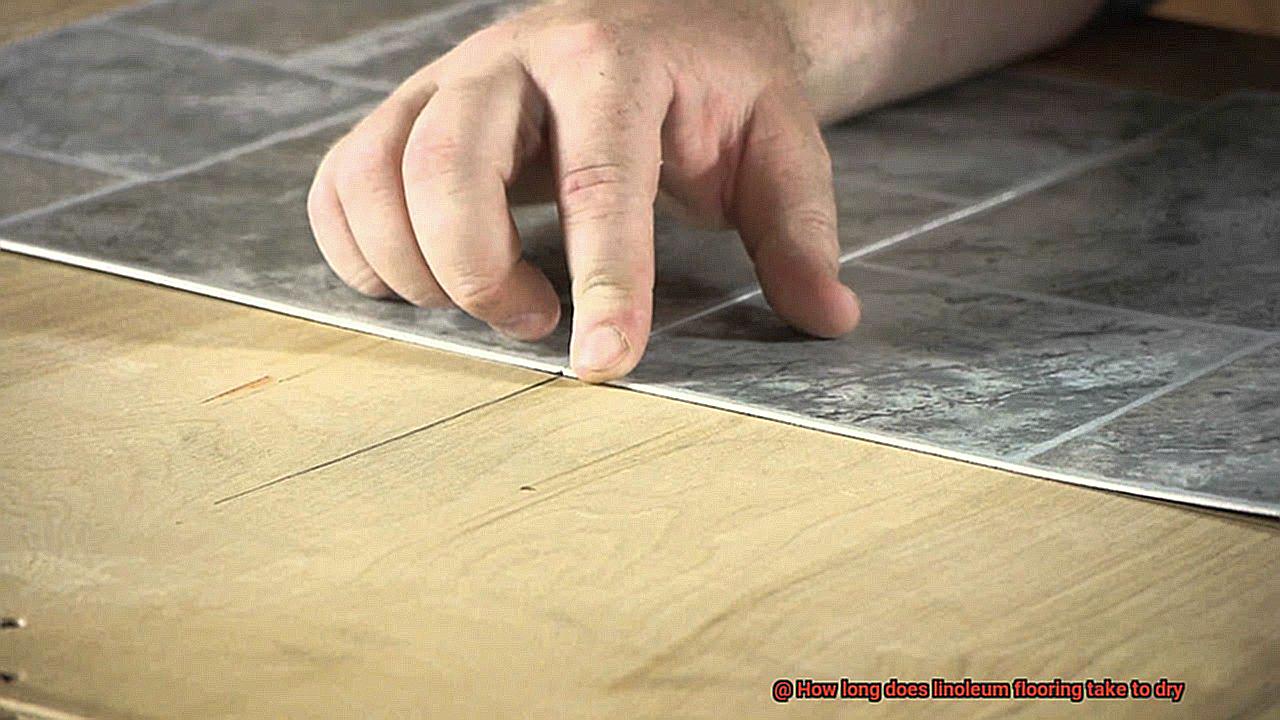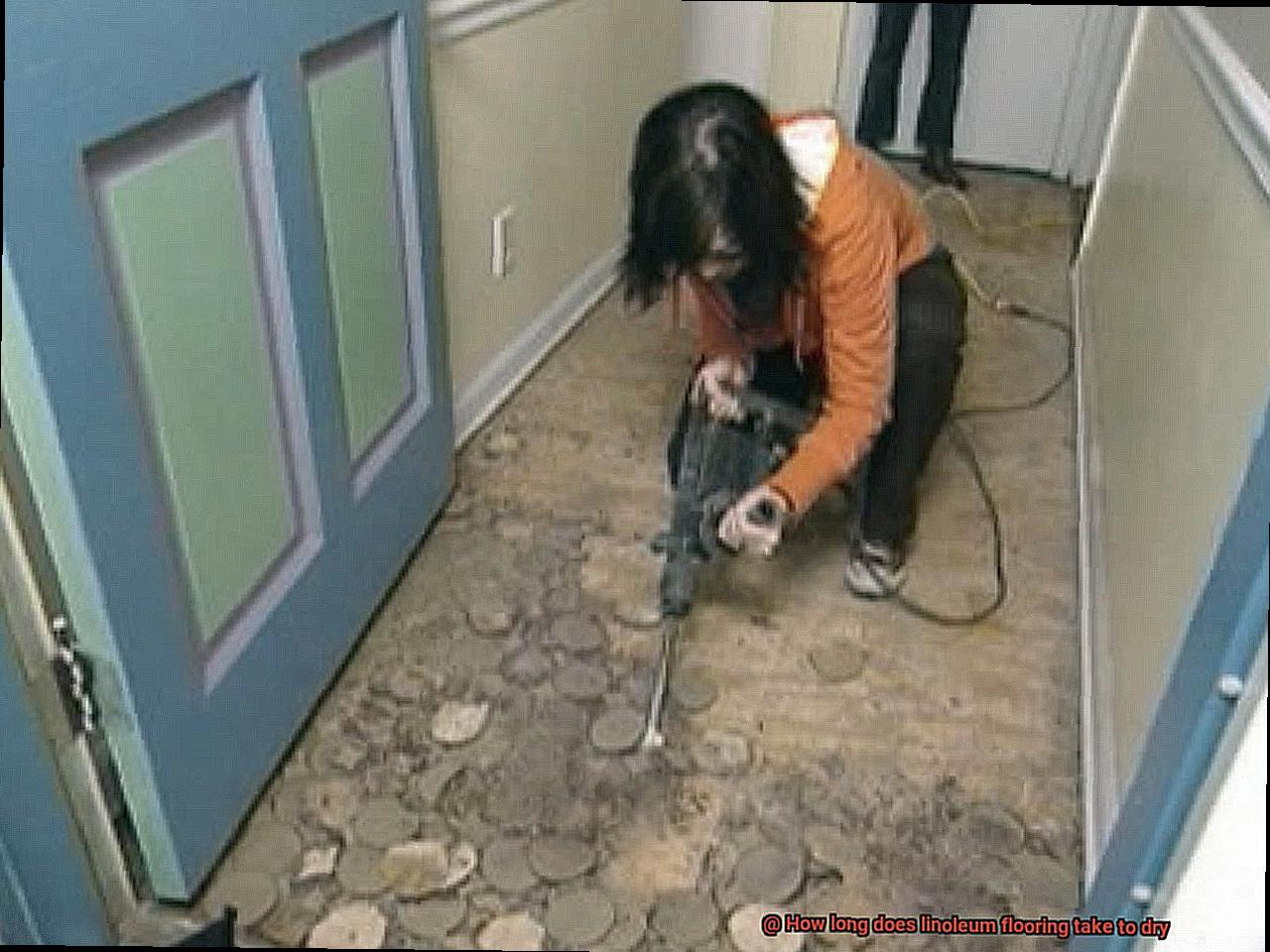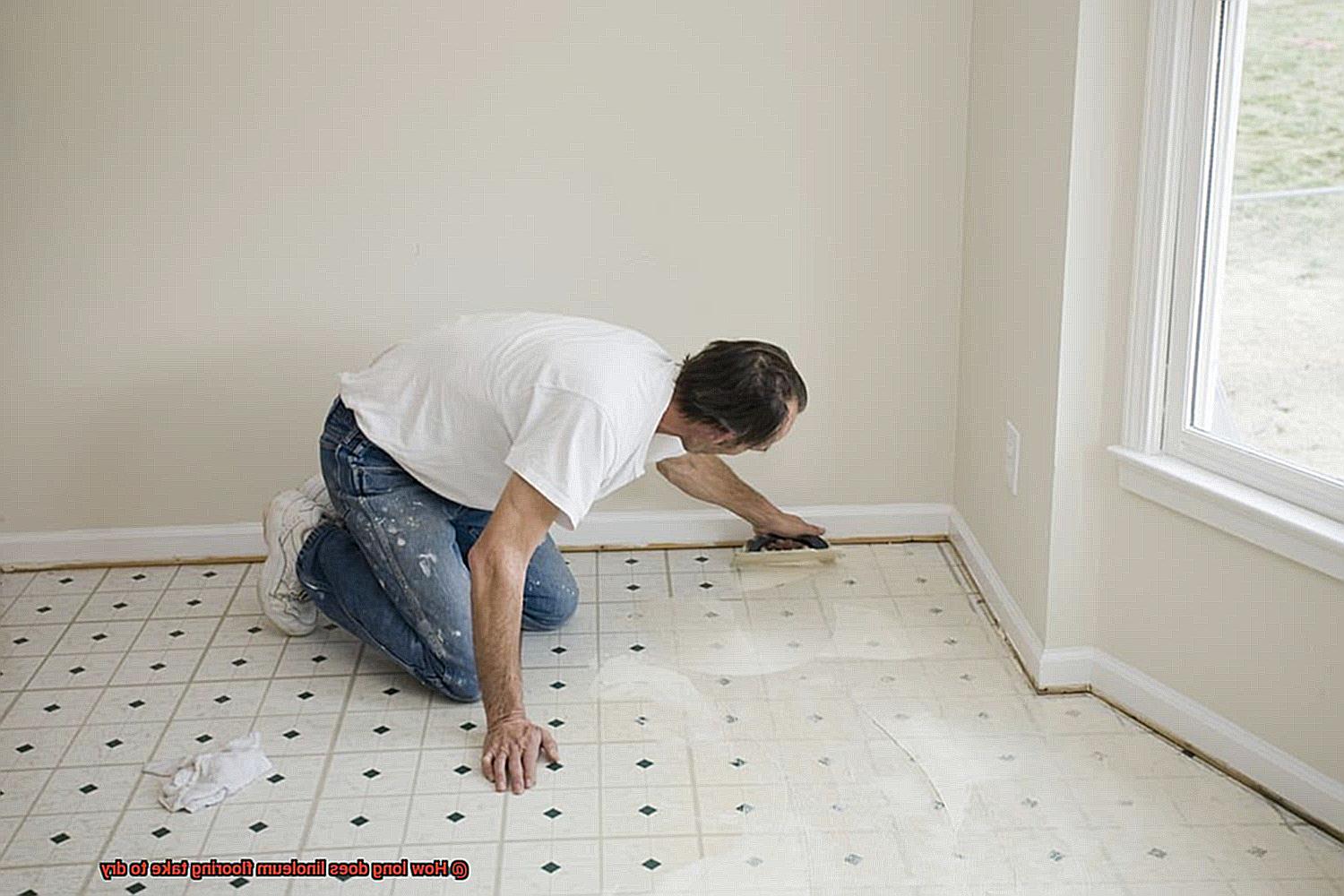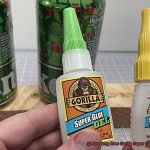Today, we’re tackling a question that pops up a lot when it comes to linoleum floors: how long does it take for them to dry? Whether you’re jazzing up your space or just curious about when you can start dancing on your new floors, knowing the drying time is key.
So let’s get cracking and unravel the mysteries of linoleum floor drying.
What is Linoleum Flooring?
Contents
When it comes to flooring options, linoleum stands out as a durable, versatile, and eco-friendly choice. Crafted from natural materials such as linseed oil, cork powder, wood flour, and limestone, linoleum offers a range of benefits that make it popular among homeowners and commercial spaces alike.
Durability:
With its protective layer of linseed oil, linoleum flooring is highly resistant to scratches, stains, and dents. This makes it the perfect choice for high-traffic areas like kitchens, hallways, and commercial spaces. Its ability to withstand wear and tear ensures that your floors will remain beautiful for years to come.
Eco-friendly:
If you’re seeking an environmentally friendly flooring option, look no further than linoleum. Primarily made from renewable resources, linoleum is a sustainable choice compared to other types of flooring. It is also biodegradable, meaning it will break down naturally over time without harming the environment.
Versatility:
Linoleum flooring comes in a wide range of colors, patterns, and textures, allowing you to create the perfect look for your space. Whether you prefer a classic solid color or want to make a bold statement with patterns or faux wood finishes, linoleum offers endless possibilities for customization.
Easy Maintenance:
Keeping your linoleum floors looking their best is a breeze. The smooth surface can be easily swept or vacuumed to remove dust and debris. Linoleum is also resistant to moisture, allowing you to safely clean it with water-based solutions without worrying about warping or damage.
Cost-effective:
Linoleum flooring is an affordable option that offers excellent value for money. Its long lifespan and low maintenance requirements make it a cost-effective choice in the long run.
Factors that Affect Drying Time
When it comes to installing linoleum flooring, drying time is a crucial factor to consider. Understanding the various factors that can affect drying time is essential for ensuring a successful installation. Let’s dive into the details and explore the key factors that play a role in how quickly linoleum flooring dries.
- Type of Adhesive: The type of adhesive used during installation has a significant impact on drying time. Different adhesives have different properties and drying times. Some adhesives may dry quickly, while others may take longer to fully cure. To ensure proper drying time, it is important to carefully follow the manufacturer’s instructions for the specific adhesive being used.
- Humidity and Temperature: Environmental conditions, such as humidity and temperature, can greatly affect the drying time of linoleum flooring. Higher humidity levels can slow down the drying process, while lower humidity levels can speed it up. Similarly, higher temperatures can accelerate drying, while lower temperatures can prolong it. It is crucial to take these factors into account during installation and adjust accordingly to achieve optimal drying time.
- Thickness of the Adhesive Layer: The thickness of the adhesive layer applied during installation also impacts drying time. Thicker adhesive layers take longer to dry compared to thinner ones. Following the manufacturer’s recommended thickness for the adhesive ensures proper drying and bonding of the linoleum flooring.
- Ventilation: Adequate ventilation is vital for expediting the drying process. Proper air circulation helps remove excess moisture from the installation area, allowing the linoleum flooring to dry more quickly. Opening windows, using fans, or employing a dehumidifier can improve ventilation and promote faster drying.
- Subfloor Condition: The condition of the subfloor can significantly affect drying time. If the subfloor is damp or has high moisture content, it can delay the drying of the adhesive and prolong overall drying time for the linoleum flooring. Ensuring that the subfloor is dry, clean, and properly prepared before installation is crucial to avoid complications with drying.
- Flooring Thickness: The thickness of the linoleum flooring itself also impacts drying time. Thicker linoleum may take longer to dry compared to thinner options because more adhesive is required for installation. It is important to consider the thickness of the linoleum flooring when estimating drying time and allow sufficient time for it to fully dry.
Water-Based Adhesive Drying Time
Water-based adhesives are commonly used for linoleum flooring installation due to their eco-friendly nature and ease of use. Understanding the drying time of these adhesives is essential for a successful and long-lasting installation.
Generally, water-based adhesives take approximately 24 to 48 hours to dry completely. However, it is crucial to follow the manufacturer’s instructions as drying times can vary between different brands.
Humidity levels can significantly impact the drying process. Higher humidity levels can prolong drying time, while lower humidity levels can expedite it. To create optimal drying conditions, it is recommended to install linoleum flooring in a well-ventilated room with a humidity level between 40% to 60%.
Temperature is another important factor. Warmer temperatures accelerate drying, while cooler temperatures slow it down. The ideal temperature range for water-based adhesive drying is typically between 65°F to 85°F (18°C to 29°C). Avoid extreme temperatures and direct sunlight, as they can affect the adhesive’s performance and drying time.
Adhesive thickness also affects drying time. Thicker applications will require more time to dry compared to thinner ones. Follow the manufacturer’s recommendations for proper bonding and drying to ensure the best results.

To ensure a secure bond, it is important to wait at least 24 hours before allowing foot traffic or placing heavy objects on the newly installed linoleum flooring. This waiting period allows the adhesive to cure and bond with the subfloor, reducing the risk of damage or premature wear.
Solvent-Based Adhesive Drying Time

When it comes to linoleum flooring installation, solvent-based adhesives are the go-to choice for many professionals. They offer a strong and durable bond that can withstand the test of time. But how long do these glues take to dry? Well, my friend, it all depends on a few key factors.
First off, let’s talk about the brand of adhesive you choose. Different manufacturers may have different formulations, which can affect drying time. So, make sure to read the label and follow the manufacturer’s instructions when it comes to drying time. They know their product best, after all.
Now, let’s talk about the environment. Ambient temperature and humidity levels play a significant role in how quickly the adhesive dries. If you’re working in a chilly room or a humid climate, you may need to wait a little longer for that glue to set. On average, solvent-based adhesives for linoleum flooring take anywhere from 24 to 72 hours to dry completely. Patience is key here, my friend.
To speed up the drying process, keep the room well-ventilated. Open those windows, turn on a fan, or even use a dehumidifier if needed. Good airflow helps evaporate the solvents in the adhesive and speeds up drying time. But remember, don’t go overboard with heat. Excessive heat can cause the adhesive to dry unevenly and compromise the bond with your linoleum flooring.
Once your linoleum flooring is installed and the adhesive is dry, give it some additional curing time before subjecting it to heavy traffic or placing heavy objects on top. This can take several days to a week, depending on the specific adhesive and environmental conditions.
Thickness of the Adhesive Layer and Subfloor Type
The relationship between the thickness of the adhesive layer and the type of subfloor is a crucial aspect to consider when it comes to installing linoleum flooring. These factors have a significant impact on the overall drying time, which directly affects the success and durability of the installation.
Let’s start by discussing the thickness of the adhesive layer. Contrary to popular belief, thicker isn’t always better in this case. While a thicker adhesive layer may provide better adhesion and durability, it also requires more time to dry completely. On the other hand, a thinner layer may dry faster but might not provide as strong of a bond. Striking the right balance is essential, so it’s crucial to follow the manufacturer’s guidelines for adhesive application to achieve the correct thickness and ensure proper drying.
Now, let’s delve into the influence of subfloor type on drying time. Different subfloor materials have varying moisture retention properties that can affect how long it takes for linoleum flooring to dry. For instance, concrete subfloors tend to retain more moisture compared to plywood. This increased moisture retention can result in a longer drying time for linoleum flooring. To mitigate this issue, it’s crucial to properly prepare the subfloor before installation, ensuring any moisture-related issues are addressed and allowing for adequate drying.
In addition to adhesive layer thickness and subfloor type, other factors can also influence drying time. The brand of adhesive used can have different drying times, so it’s important to read and follow the instructions provided. Moreover, environmental conditions like temperature and humidity play a significant role in drying time. Higher temperatures and lower humidity levels tend to promote faster drying.
Allowing Sufficient Time for Drying
But before you start dancing a jig or moving furniture, there’s an important step you shouldn’t overlook – allowing sufficient time for drying. In this blog post, we’ll explore why patience is crucial when it comes to drying linoleum flooring and provide tips to expedite the process.
Why Does Drying Time Matter?
Linoleum flooring is made of natural materials like linseed oil, cork dust, and wood flour. During installation, a special adhesive is used to bond the linoleum to the subfloor. Giving this adhesive enough time to dry completely ensures a strong and long-lasting bond that will stand the test of time.
Factors Affecting Drying Time:
Several factors influence how long it takes for linoleum flooring to dry. These include the type of adhesive used, humidity levels, temperature, and ventilation in the room. Thicker adhesive layers take longer to dry, while thinner layers may compromise the bond’s strength. Concrete subfloors tend to prolong drying time due to their moisture-absorbing properties. Additionally, environmental conditions like temperature and humidity can either speed up or slow down the drying process.
To help your linoleum flooring dry faster, follow these tips:
- Maintain proper ventilation: Open windows or use fans to ensure good air circulation and expedite evaporation.
- Control humidity levels: Use dehumidifiers or heaters to reduce moisture in the room. Aim for a relative humidity below 60% for optimal drying.
- Keep the temperature moderate: Maintain a temperature around 70°F (21°C) as it facilitates faster evaporation and drying.
- Regularly inspect for moisture or soft spots: Check for any signs of moisture or soft areas in the flooring during the drying process. This can indicate insufficient drying or potential issues with the adhesive.
- Follow manufacturer instructions: Adhesives may have specific drying times recommended by the manufacturer. It’s crucial to adhere to these instructions for the best results.
Ways to Expedite the Drying Process
Linoleum flooring is a popular choice due to its durability and aesthetic appeal. However, the drying process after installation can be time-consuming. In this article, we will explore various methods and techniques to expedite the drying process of linoleum flooring. By implementing these tips, you can enjoy your beautiful floor sooner.
Increase Air Circulation:
Proper ventilation is essential for quick drying. Open windows and doors to allow fresh air to circulate in the room. Additionally, use fans or dehumidifiers to improve air circulation and remove excess moisture. Position fans strategically to ensure optimal airflow over the linoleum surface. This will help speed up evaporation and reduce drying time significantly.
Apply Heat:
Heat is an effective way to expedite the drying process of linoleum flooring. However, caution must be exercised to avoid damage. Use portable heaters or radiant heating systems to gently warm up the room. Ensure even distribution of heat across the floor surface. This will promote faster evaporation of moisture without compromising the integrity of the linoleum or adhesive.
Utilize Fans:
Fans are your best friends when it comes to drying linoleum flooring quickly. Place them strategically around the room to encourage air movement and enhance evaporation. Point fans towards the floor surface to circulate air beneath and above the linoleum tiles or sheets. This will accelerate drying by removing moisture from all layers.
Follow Manufacturer’s Instructions:
Each adhesive used for linoleum flooring has specific requirements for drying time. It is crucial to carefully read and follow the manufacturer’s instructions. Ignoring these guidelines can lead to subpar results or damage to the flooring. Adhering to the recommended drying time ensures a proper bond between the linoleum and subfloor, resulting in a long-lasting floor.
Seek Professional Assistance:
If you are dealing with a large area of linoleum flooring or if you are unsure about the drying process, consider seeking professional assistance. Flooring professionals have the expertise and equipment to expedite the drying process effectively. They can assess the specific conditions of your space and provide tailored solutions to ensure a quick and successful drying process.
9MfEfBH6Ptw” >
Conclusion
In conclusion, the drying time of linoleum flooring is influenced by a variety of factors. These factors include the type of adhesive used, humidity levels, temperature, ventilation, thickness of the adhesive layer, and subfloor condition. Understanding these factors is crucial for a successful installation and allowing ample time for the linoleum flooring to dry completely.
When it comes to water-based adhesives, you can expect them to dry completely within 24 to 48 hours. On the other hand, solvent-based adhesives may take anywhere from 24 to 72 hours. It’s important to carefully follow the manufacturer’s instructions for specific drying times as they can vary between different brands.
To speed up the drying process, there are several steps you can take. First and foremost, ensure proper ventilation in the area where the linoleum flooring is being installed. This will help facilitate air circulation and aid in moisture evaporation. Additionally, controlling humidity levels and maintaining a moderate temperature will also contribute to faster drying times.
Regularly inspecting for any signs of moisture or soft spots is essential during the drying process. By catching these issues early on, you can address them promptly and prevent any potential damage to your linoleum flooring.
Applying heat cautiously and strategically utilizing fans can also assist in expediting the drying process. However, it’s important to exercise caution when using heat as excessive heat can cause damage to both the linoleum flooring and surrounding materials.
Before subjecting your linoleum flooring to foot traffic or placing heavy objects on top of it, be sure to allow sufficient time for drying. This waiting period allows the adhesive to cure properly and bond securely with the subfloor.
If you find yourself unsure about the drying process or dealing with a large area of linoleum flooring, don’t hesitate to seek professional assistance from flooring experts. Their expertise will ensure a quick and successful drying process without compromising on quality.
Remember, patience is key when it comes to drying linoleum flooring.






